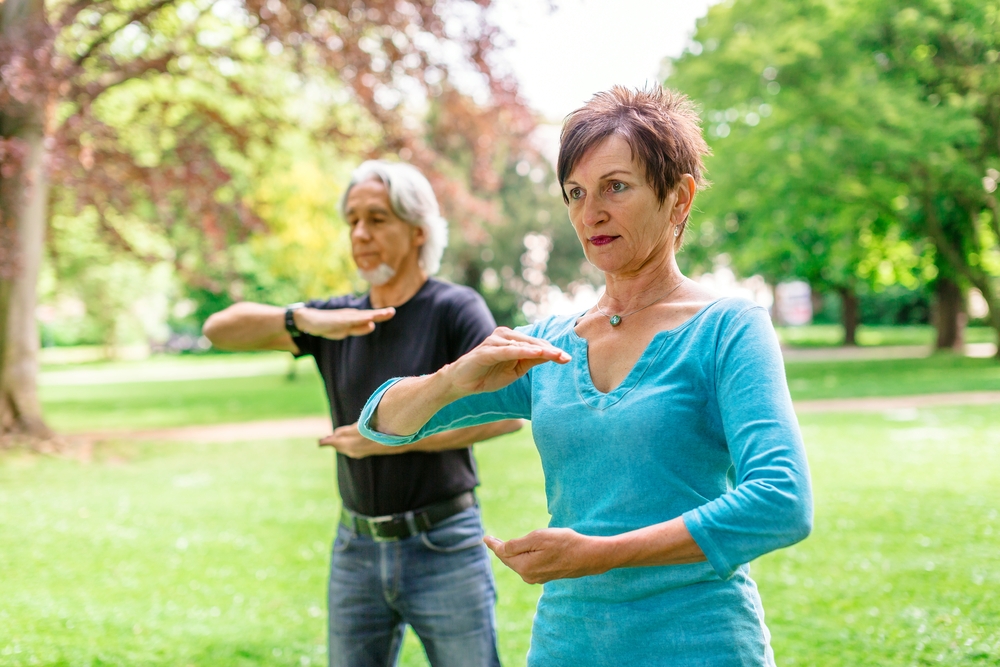Exercise That’s Tailored and Routine Can Help Patients at All Disease Stages, Therapist Says

Although exercise is beneficial for patients at all stages of Parkinson’s disease, a regular routine should be in place before movement issues become pronounced, an expert who led a presentation hosted by The Parkinson Voice Project advises.
The theme of the free Feb. 9 talk by Michael Braitsch, a kinesiology professor, board-licensed doctor of physical therapy, and certified fight referee, was “Packing Some ‘Punch’ Into Your Parkinson’s Exercise Routine.”
Part of the Parkinson’s Lecture Series that features disease experts, the presentation is available online, complete with explanatory graphics and videos of patient testimonials. The lecture was held at the Project’s Clark and Brigid Lund Parkinson’s Education Center in Richardson, Texas. Presentations may be viewed in person or through the website.
The most important thing for Parkinson’s patients is to get moving, often, and earlier rather than later, said Braitsch, who treats individual patients in addition to leading group exercise programs to help those with chronic conditions move and feel better.
“A lot of folks in the medical community would wait until people start falling, or until they’re having major problems with mobility, to prescribe physical therapy,” he said. “A lot of people are more forward thinking now.”
Interested in Parkinson’s Disease research? Sign up for our forums and join the conversation!
Braitsch said that while exercise is good for everyone, it’s particularly valuable for those with movement disorders. Exercise can slow disease progression, and help to improve patients’ quality of life.
“While we know that exercise is medicine for anyone, for people with Parkinson’s it’s so much more important than for the Average Joe,” he said, adding that Parkinson’s motor symptoms mimic normal aging in many ways — only they’re sped up and intensified.
Key factors in any exercise program include repetition, intensity, task duration, and consistency. “Stick with it, keep going, do not quit,” he said. “You can make big changes.”
The trick to consistency often is finding a routine that’s safe, fun and relatively quick, said Braitsch, a board member of the Adaptive Martial Arts Association and the University of Texas Southwestern Medical Center Adaptive Sports Expo.
Because each patient experiences Parkinson’s uniquely, tailored and one-on-one routines are best. Still, he said, group programs with skilled leaders are also worthwhile, fostering consistency, motivation, performance, community, camaraderie, support and idea sharing.
“Depression, isolation, it starts a negative feedback loop. So, that’s where a tribe helps,” said Braitsch, who offers Tai Chi and Southpaws boxing classes for people with Parkinson’s. “Strength in numbers means we all do better together.”
For many Parkinson’s patients, regular exercise is typically prompted by a recent status change, a propensity to fall, freezing episodes, weakness, balance problems, issues with gait, or an acute flair up of chronic episodes, Braitsch said.
Workouts can prevent or alleviate those and other motor symptoms, including slowness of movement (bradykinesia), loss of spontaneous and voluntary movement, rigidity, resting tremors, uncontrollable movement, postural instability, and coordination issues, he said. Along with the body’s core, chronically weak muscle groups for Parkinson’s often include the neck, shoulders, legs, back and hips.
Aerobic exercise also promotes better sleep, boosts energy, improves moods, blood flow and cognitive performance, he added. Non-motor Parkinson’s symptoms can range from depression and anxiety to hallucinations, memory problems and dementia.
“There are two categories of patients,” Braitsch said, “those who exercise and those who don’t. Those who do tend to do much better.”
While those living with Parkinson’s should not think of exercise as replacing the need for medicine, Braitsch said research shows that aerobic exercise helps reduce the amount of carbidopa-levodpa necessary to manage symptoms. This treatment works to increase dopamine levels in the brain to make movement easier, but it cannot salvage damaged neurons.
“People tell me that when they exercise they feel more awake and more with it,” he said, adding that many patients begin to feel better within the first few weeks of a regular routine. “That’s the aerobic training effect.”
While specific training is encouraged for specific ailments, exercise programs should generally focus on flexibility and strengthening what’s physically weak, Braitsch said. Key elements of an effective program includes weight shifting, dynamic movement, multiple planes of motion and direction, and axial rotation.
Non-contact boxing training, which includes cross training and tempo training, also offers intensity, the satisfaction that accompanies skill acquisition, footwork, dynamic movement and weight shifting, he said.
Likewise, Tai Chi, yoga, Pilates and stretching are particularly conducive to flexibility. For strength, Braitsch suggests adding supervised workouts with free weights or weight machines. For balance and posture, engage back and core muscles. Dancing, running, walking, cycling and even kickboxing — if it’s safe — can also reap significant dividends.
Because what it means to work out intensely varies from patient to patient, it’s important to self-monitor, he said. “You might burn through medications and cause a spike in symptoms,” he said, stressing that patients should consult their movement specialist before starting any exercise program.
“Doing it is the key, and doing it safely and consistently,” he said.
In preclinical and early Parkinson’s stages, exercise offers an abundance of neuroprotection, Braitsch said. For those in the early to middle disease stages, workouts can optimize brain function, make repairs, and strengthen neural pathways overall. In later stages, goals should emphasize adaptation, maximizing function, and preventing further problems associated with a sedentary lifestyle.
“Everyone can do better and everyone can improve something,” he said, noting that wheelchair-bound patients also benefit from exercise. “It’s never too late and never too early to take action.”






